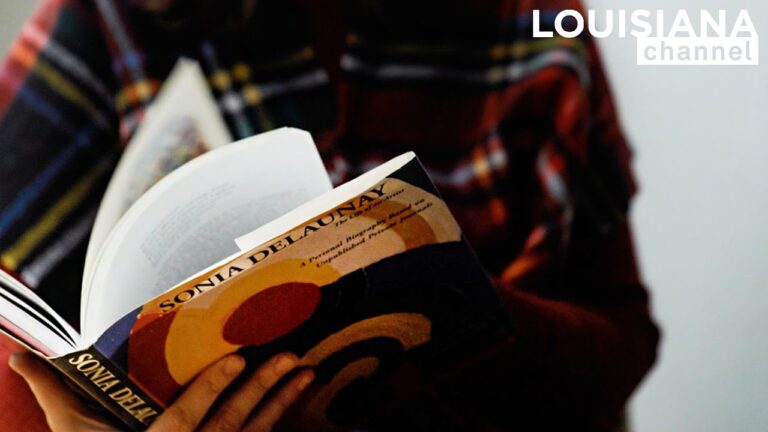
Subscribe to our channel for more videos on art and design: https://www.youtube.com/thelouisianachannel
“She just did it. She was a doer, not a thinker.” Meet the fascinating Danish designer Margrethe Odgaard who reflects on her relationship with artist Sonia Delaunay in this video.
“To begin with, it was about what she created. Later on, what I have very much appreciated in her work are her energy and entrepreneurship. Delaunay was an artist who didn’t distinguish between life and museums. She was open to using every kind of media in her expression.”
Sonia Delaunay was born into a Jewish family in Odessa, Russia (now Ukraine), as Sara Élievna Stern. Her parents gave her up for adoption to her mother’s well-off brother, Henri Terk, in St. Petersburg. She spent her childhood immersed in art and art books, took French, German, and English lessons, and went on European vacations with her family.
At age 18, she moved to Karlsruhe, Germany, to attend art school. A few years later, she went on to Paris to continue her education surrounded by the latest trends in the world centre of modern art. Delaunay briefly explored figurative painting, but above all, she cultivated colour in abstract compositions, in painting and design, from 1911 and up to her death in 1979, at age 94.
In 1910, Sonia Terk married Robert Delaunay (1885-1941), a painter her age. The two artists worked closely together in an ongoing exchange of artistic ideas until Robert’s untimely death in 1941. Sonia and Robert Delaunay had a vast network across the European and Russian art scenes. Their home in Paris was a meeting place for avant-garde artists and writers before and after World War I. Sonia and Robert worked closely together to develop a visual vocabulary based on rhythmic compositions of coloured planes – a colourful take on Cubism that their friend, the influential poet Guillaume Apollinaire, dubbed Orphism. Personally, Sonia Delaunay preferred the term Simultané, which even became a trademark and brand for her design and fashion work. Dynamic colour interaction was foundational to all of Sonia Delaunay’s work. Moreover, she was concerned with the interaction between different art forms, especially between experimental poetry and the abstract vocabulary of her day.
Sonia Delaunay was among the pioneers in developing and disseminating abstract art in the 1910s. She did not work with painting only but swung freely between isms and roles across the boundary between “art” and “craft”, both as an avant-gardist and an entrepreneur and was a forerunner of contemporary experimental collaborations in art and design. Linking abstract art and fashion, she helped compose the modern woman of the 1920s while embodying one herself in her lifelong artistic project to connect the new abstract vocabulary with vibrant modern life. For too long, her diverse practice excluded her from the modernist canon, primarily focused on the development of abstract painting and the differences between the isms, whilst Delaunay had a foot in many camps.
Margrethe Odgaard (b. 1978) is a Danish designer. She has collaborated with brands such as Muuto, HAY and Georg Jensen and now runs her design studio in Copenhagen, Denmark. Before setting up her studio, she worked for several years as a textile designer at the French fashion company Epice. Odgaard is also part of the duo Included Middle with furniture designer Chris L. Halstrøm. In 2016, she received the Torsten och Wanja Söderbergs Prize, one of the most prestigious design awards in the world. In 2019, Odgaard published the book ‘Shades of Light (An incomplete range of colors from a culture of slow and hesitant light)’ in collaboration with A. Petersen. The book is a 220 pages study of colors in Nordic light and the result of more than two years of work with 276 finished colors.
Margrethe Odgaard was interviewed by Marc-Christoph Wagner in connection with the exhibition SONIA DELAUNAY at the Louisiana Museum of Modern Art in the spring of 2022. The interview took place at Margrethe Odgaard’s studio in Copenhagen, Denmark, in January 2022.
Camera: Rasmus Quistgaard
Edit: Rasmus Quistgaard
Produced by: Marc-Christoph Wagner
Copyright: Louisiana Museum of Modern Art, 2022
Louisiana Channel is supported by Den A.P. Møllerske Støttefond, Ny Carlsbergfondet, C.L. Davids Fond og Samling and Fritz Hansen.
FOLLOW US HERE!
Website: http://channel.louisiana.dk
Facebook: https://www.facebook.com/LouisianaChannel
Instagram: http://www.instagram.com/louisianachannel
Twitter: http://www.twitter.com/LouisianaChann
source